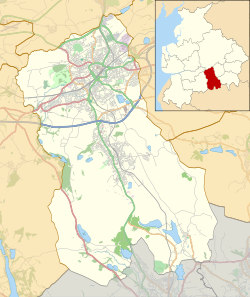
Summary
Immanuel Church is in the village of Feniscowles, near Blackburn, Lancashire, England. It is an active Anglican parish church in the deanery of Blackburn with Darwen, the archdeaconry of Blackburn, and the diocese of Blackburn.[1] The church is recorded in the National Heritage List for England as a designated Grade II listed building.[2]
| Immanuel Church, Feniscowles | |
|---|---|
 Immanuel Church, Feniscowles, from the southwest | |
 Immanuel Church, Feniscowles Location in Blackburn with Darwen | |
| 53°43′36″N 2°32′27″W / 53.7268°N 2.5408°W | |
| OS grid reference | SD 644 257 |
| Location | Feniscowles, Blackburn, Lancashire |
| Country | England |
| Denomination | Anglican |
| Website | Immanuel, Feniscowles |
| History | |
| Status | Parish church |
| Consecrated | 10 October 1836 |
| Architecture | |
| Functional status | Active |
| Heritage designation | Grade II |
| Designated | 27 September 1984 |
| Architect(s) | J. W. Whittaker (?) |
| Architectural type | Church |
| Style | Gothic Revival |
| Groundbreaking | 1835 |
| Completed | 1836 |
| Specifications | |
| Materials | Gritstone, slate roof |
| Administration | |
| Diocese | Blackburn |
| Archdeaconry | Blackburn |
| Deanery | Blackburn with Darwen |
| Parish | Immanuel, Feniscowles |
| Clergy | |
| Vicar(s) | David Roscoe |
| Assistant priest(s) | Peter Hallett |
| Laity | |
| Organist(s) | Andrew Orr |
| Churchwarden(s) | Margaret Duckworth Ken Winterburn |
| Parish administrator | Karen Woods |
History edit
The church was built in 1835–36. Its architect is uncertain.[3] In the Buildings of England series Hartwell and Pevsner credit the design to J. W. Whittaker, the Vicar of Blackburn.[4] In the National Heritage List for England it is credited to Whittaker's cousin, the Lancaster architect Edmund Sharpe.[2] Whittaker certainly made the first design for the church, but whether this was replaced or amended by Sharpe is uncertain.[3] The church cost £1,000 (equivalent to £100,000 in 2021).[5] The foundation stone was laid on 5 February 1835 by William Feilden, who had given the land for the church, and paid £100 towards its construction.[6] The church was consecrated on 10 October 1836.[3] It was restored in 1931–32 by Austin and Paley, the successors in Sharpe's practice.[7] During the restoration the original box pews were removed, a pulpit and chancel screen were added, the lower part of the walls were panelled, and the church was re-floored.[6]
Architecture edit
Exterior edit
Immanuel Church is constructed in gritstone with a slate roof.[2] Its plan consists of a nave and chancel in one cell, a southwest porch, and a west tower with a spire.[4] The tower is short, in two stages, and is embraced by the nave. It has diagonal buttresses, a two-light west window, and rectangular louvred bell openings. The spire is set back and contains lucarnes.[2] There were originally eight pinnacles, but these were removed because of erosion.[6] The windows on the sides of the church are large and straight-headed, with Perpendicular tracery. The east window contains Decorated tracery.[4]
Interior edit
Inside the church is a west gallery carried on slim iron columns. The stained glass in the east window is dated 1861 and is possibly by Hardman & Co. On the north side of the church are windows dating from the early 20th century by Heaton, Butler and Bayne, and on the south side, dated 1907, are windows by Curtis, Ward and Hughes.[4] The two-manual organ in the west gallery was built by Jardine and Company in 1949, when some of the pipes from the earlier organ built in 1899 by Ernest Wadsworth were reused.[8] The church bell is an eighteenth-century Javanese bell with a dated Javanese inscription originally from Gresik in East Java and donated by a member of the Feilden family who served in Egypt, India and Java during the Napoleonic Wars.[6][9]
See also edit
References edit
- ^ Immanuel, Feniscowles, Church of England, retrieved 12 September 2011
- ^ a b c d Historic England, "Church of Immanuel, Livesey (1163235)", National Heritage List for England, retrieved 12 September 2011
- ^ a b c Hughes, John M. (2010), Edmund Sharpe: Man of Lancaster, John M. Hughes, p. 115 Although this is self-published, it is a scholarly work and fully referenced throughout. (As of 2011 it is available only as a CD.)
- ^ a b c d Hartwell, Clare; Pevsner, Nikolaus (2009) [1969], Lancashire: North, The Buildings of England, New Haven and London: Yale University Press, p. 129, ISBN 978-0-300-12667-9
- ^ UK Retail Price Index inflation figures are based on data from Clark, Gregory (2017). "The Annual RPI and Average Earnings for Britain, 1209 to Present (New Series)". MeasuringWorth. Retrieved 11 June 2022.
- ^ a b c d History, Immanuel Church, Feniscowles, retrieved 12 September 2011
- ^ Price, James (1998), Sharpe, Paley and Austin: A Lancaster Architectural Practice 1836–1942, Lancaster: Centre for North-West Regional Studies, p. 99, ISBN 1-86220-054-8
- ^ Lancashire, Feniscowles, Immanuel (N10939), British Institute of Organ Studies, retrieved 12 September 2011
- ^ Gomperts, Amrit; Carey, Peter (1994), "Campanological Conundrums; A History of Three Javanese Bells", Archipel, vol. 48, pp. 13–31


